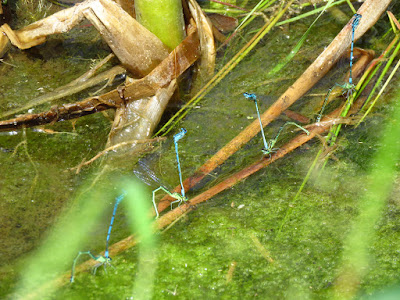Although they are great fun to watch, they are a bit distant, so I decide to walk by the drain and see if I can get closer views. As the drain runs closer to the River Hull I climb the bank to have a look at the river and it is on the river bank when I find a settled female on a willow, and later of a male, which alights close to the female. There are many settled males on the grassy bank, I count 15 individuals in a short stretch of river.
A male Banded Demoiselle on the River Hull, with some male Azure damselflies.
Female Banded Demoiselle.
Male Banded Demoiselle.
I cross the bridge to Stork Hill Wood, a place I haven't been before. From the bridge, more Banded Demoiselles and Azure damselflies ovipositing.
Stork Hill Wood was planted in 2004, a board informs me, and the map shows a small pond in the middle, so I head for it. The water level is quite low and it looks like it might dry any day, but there are many Azure Damselflies ovipositing and a single male Large Red Damselfly. An Emperor flies past at some point but doesn't settle.
Azure Damselfly.
Ovipositing Azure damselflies.
Mayfly in Stork Hill Wood (Ephemera vulgata)
Azure Damselflies were ovipositing everywhere, these on the Stork Hill Wood pond.
Male Large Red Damselfly.
On my return I walk to the ford on the drain in Swinemoor. There is a nice patch of Potamogeton with ovipositing Azure damselflies, but I also find a teneral and a male Common Blue and a male Red-eyed damselfly patrolling away from the shore, a very distinctive species even from a distance, with a strong flight and a distinctive dark thorax, with a bright blue band near the tip of the abdomen.
Teneral female Common Blue damselfly.
Male Common Blue Damselfly.
Pair of Azure Damselflies in tandem.
Male Red eyed Damselfly, it only settled in the middle of the drain.
As I got to the car I had a last look at the Banded Demoiselles on the drain, I was rewarded by a Water Vole, crossing the drain and disappearing into the sweet reed grass, a great end to a great day!



















No comments:
Post a Comment